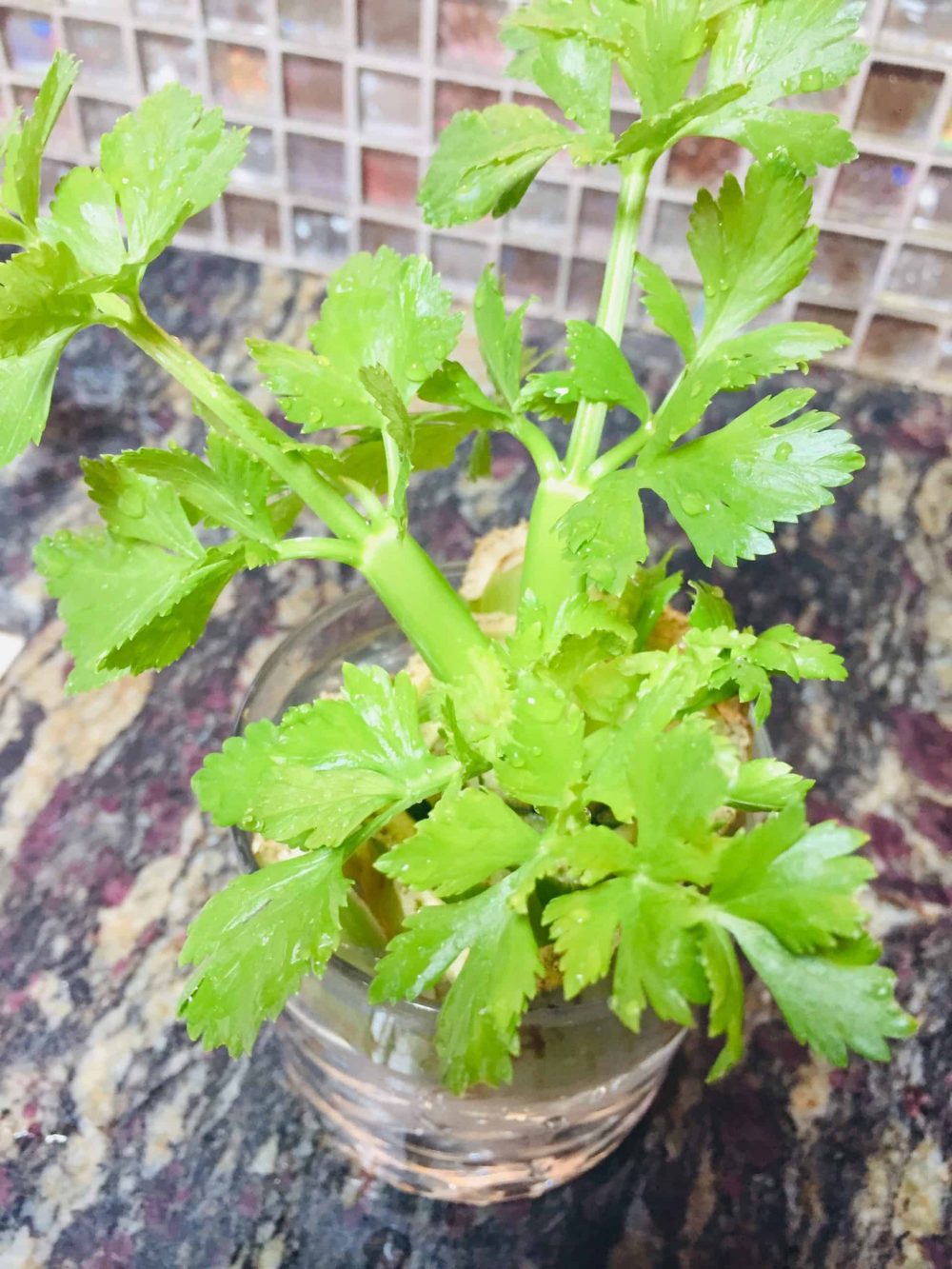For crisp stalks full of flavor, read these tips for how to grow celery. You’ll want to ensure it isn’t watery, bitter or too stringy. Beginners should start by growing from grocery store celery. Experienced gardeners can grow from seeds or starts.
With fresh potting soil, it grows well in pots and containers. You can also grow celery in water.
A cool weather crop, it has a low tolerance for heat. This makes it ideal to grow as a:
- Summer crop in the far northern states
- Fall crop in the central states
- Winter crop in the south
Celery grows best in climate zones 4 – 10. Whatever your climate, you’ll need patience. It’s a slow-growing vegetable with a long growing season. It takes four and a half months to grow. Celery is a biennial grown as an annual. It’s scientific name is Apium graveolens. It’s part of the parsley and carrot family.
Where to Grow Celery
Choose an area that receives 5 – 7 hours of sun each day. You can grow it right in the ground in a garden, in a garden bed, or in pots and containers. It doesn’t take a lot of room to grow as it grows up instead of out.
Roots are 2 – 3 inches deep. You can grow celery plants in a pot or container as long as it’s a minimum of 10 inches in diameter. Roots spread wider than they go deep. An advantage of growing in a pot is there may be less weeds. If you keep the containers close to your home or on a patio, there may be less pests as well.
Spacing
Whether you are planting seedlings you started indoors, celery starts, or store-bought, when you plant celery outdoors, be sure to space them 6 – 10 inches apart. If you are planting in rows, leave 18 – 24 inches between rows.
Depending on the variety, they can grow from 6 – 12 inches wide. Ensure there is enough space between plants for individual stalks to get direct sunlight and air circulation.
How to Grow Celery
How to Grow Celery from Celery
Another option is to grow celery from store-bought celery indoors. This is also called growing celery from scraps or growing celery from stalks. This makes better use of it than throwing away or adding the to your compost.
Choose organic celery if possible. Be sure it’s firm and not limp.
To grow celery from celery:
- Take the bunch of celery and cut off the celery stalk base, leaving two inches from the base.
- Insert toothpicks into the sides and hang on the rim of the container so the celery is in the bowl of water but doesn’t touch the bottom of the container.
- Put the base with the end side in water.
- Spritz with warm water daily.
- Change the water every few days.
After a week, new growth will form from the center. When roots are 1 – 2 inches long, replant in soil. You can continue growing indoors or transplant it outside if it’s the right season and temperature.
Growing Celery from Starts
You may find celery starts at your local hardware store, garden center, or grocery store. These are celery plants that are already growing. They will be several inches tall. Transplant them into the garden two weeks before the last frost or when each plant has at least six leaves.
Growing Celery from Seed
Celery is considered difficult to grow from seed and not recommended for beginner gardeners. One of the reasons is celery seeds often don’t germinate.
- Soak celery seeds overnight before planting.
- Plant seeds 1/8″ – 1/4″ deep.
- The seeds are tiny; leave two inches between seeds.
With ideal conditions, they’ll germinate in 7 – 20 days. Check the soil during the germination period to ensure it’s moist. Water when necessary.
After a few weeks of growth, snip the weak seedlings and leave the larger, stronger ones. It’s important to thin them so only one plant remains when planting. Transplant outdoors when they have five or six leaves. Soil temperature should be a minimum of 50 degrees Fahrenheit.
When to Plant Celery Seeds
Depending on your climate, you can start seeds 8 – 12 weeks before the last frost. Start them indoors if you live in a cold climate. This means you should plant them indoors in December through January.
Plant outdoors in early spring when soil temperature is 50 degrees Fahrenheit or warmer.
Note: If you live in USDA hardiness zones 9 or 10, plant in the fall or winter. It’s not recommended to start growing in the spring and into summer. Celery thrives in cooler temperatures.
If you want to grow during the summer, find an area with morning sun and keep it out of the afternoon sun. It will need a lot of water. You can also grow it indoors.
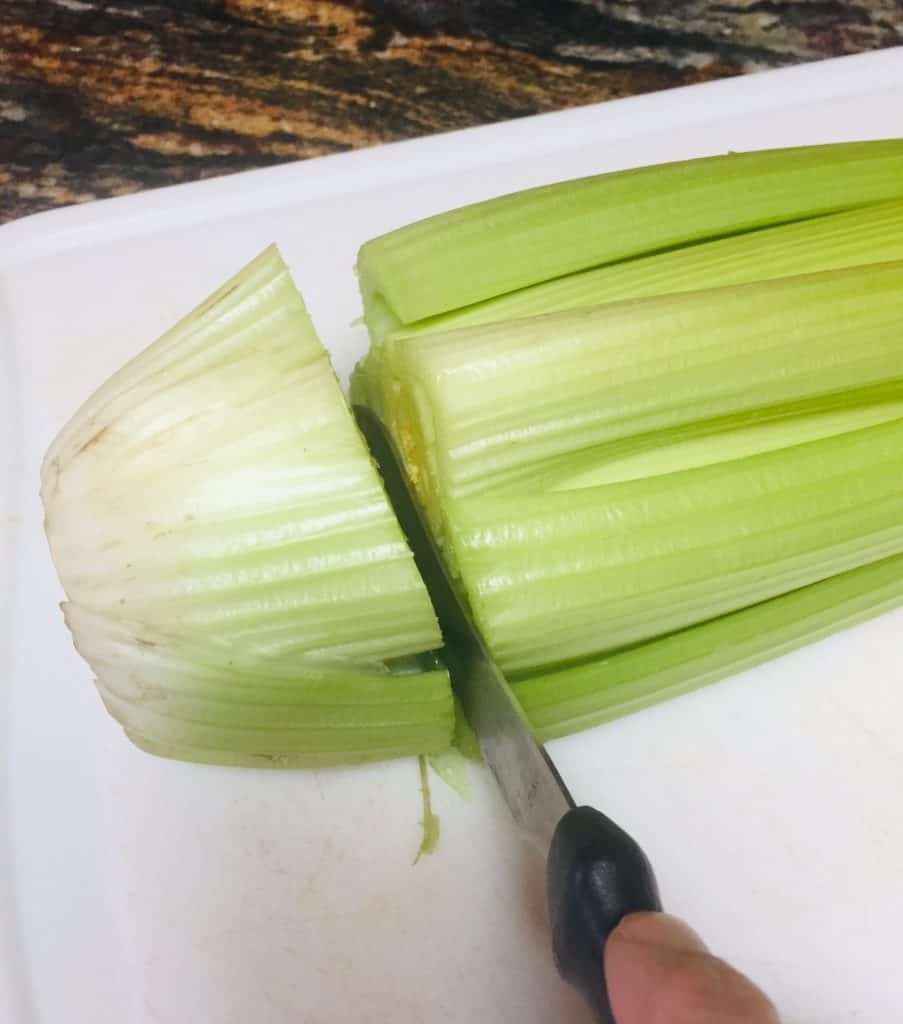
What Celery Needs to Grow Well
Soil requirements for celery
Choose moisture-retentive, nutrient rich soil. Consider enriching potting soil with compost. Fertile soil with organic matter will be important as it has shallow roots. Celery roots will derive nutrients from the top layer. Soil should be moist. It will thrive in neutral soil with pH between 6.5 – 7.5.
Fertilizer
Plants will benefit from a balanced fertilizer in the beginning. They are considered to be heavy feeders. Later, you can add fertilizer higher in potassium or with a ratio of 4-4-8 or 5-10-10.
In addition to feeding with fertilizer, continue to amend soil with compost. This will provide nutrition as well as help retain moisture. You can add coffee grounds as well.
Watering celery plant
In dry climates, water 2 – 3 inches per week. In moderate climates, water 1 – 1.5 inches per week. If it doesn’t get enough water, it will become stringy.
It’s important to water regularly, during the entire growing season, even once the plant is established. Consider setting up irrigation to get sure it gets plenty of water, especially in the summer.
Be sure the soil remains moist but not damp between waterings so it doesn’t get root rot. Consider rainfall so you don’t overwater.
Companion plants
It typically doesn’t have companion plants. For certain, don’t plant root vegetables nearby as they will compete for the same nutrients. The best way to grow celery is with other celery to support blanching.
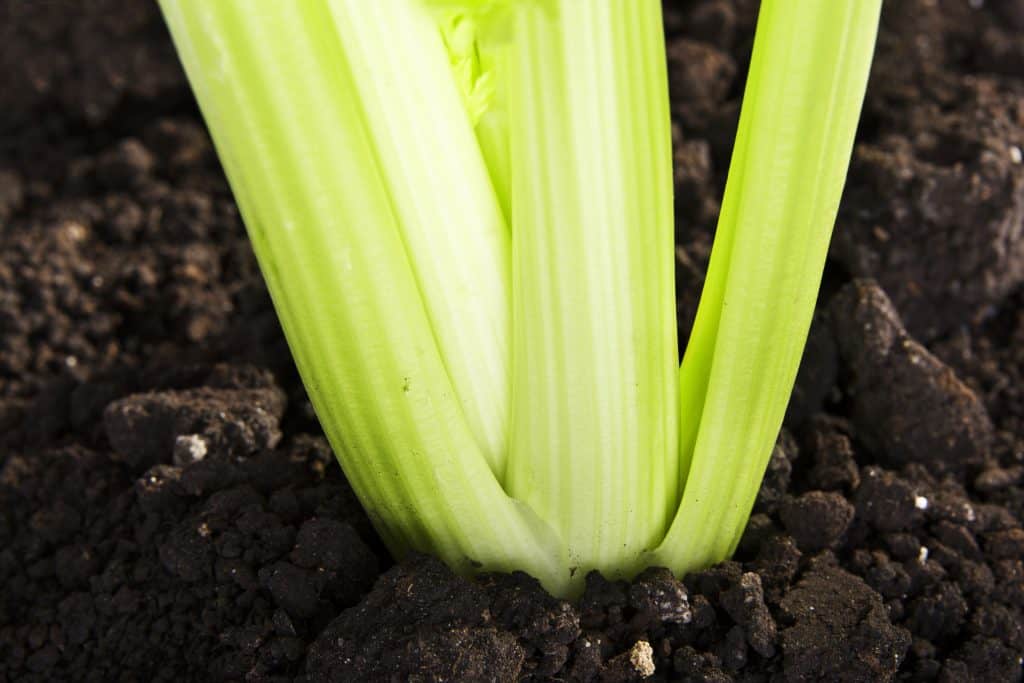
Blanching celery
Blanching celery is a technique that can reduce the bitterness of the stalks. It involves protecting the plant from the sun.
Shading the stalks may happen naturally when growing multiple plants together. However, if they don’t naturally shade each other, consider blanching, especially 3 to 4 weeks before harvesting. While blanching is not essential for the growth of the stalks and leaves, it does help in keeping the roots cool.
Blanching results in the stalks turning a lighter green and white. Reduced exposure to sunlight during blanching generally makes the celery taste less bitter, though it’s important to remember that darker green stalks, which haven’t been blanched, contain more nutrients than the lighter ones.
For ease, you can choose a self-blanching variety, like the Golden Self-Blanching. If you have a different variety of celery, there are two methods to blanch, but it’s crucial to ensure the plants still have access to sunlight.
- Cover celery base and stalks lightly with paper bags or newspaper
Tuck the newspaper into the soil to secure it and wrap it around the plant. Bring the newspaper or paper bags up to just under the leaves. You can also use burlap sacks or other protection.
- Mound with dirt
If you live in a rainy climate, consider hilling. With this method, instead of covering the ribs with newspaper, you cover them with soil and/or mulch.
Every few days or after watering or rainfall, you’ll need to add more dirt. As in the above method, mound up until you reach the leaves.
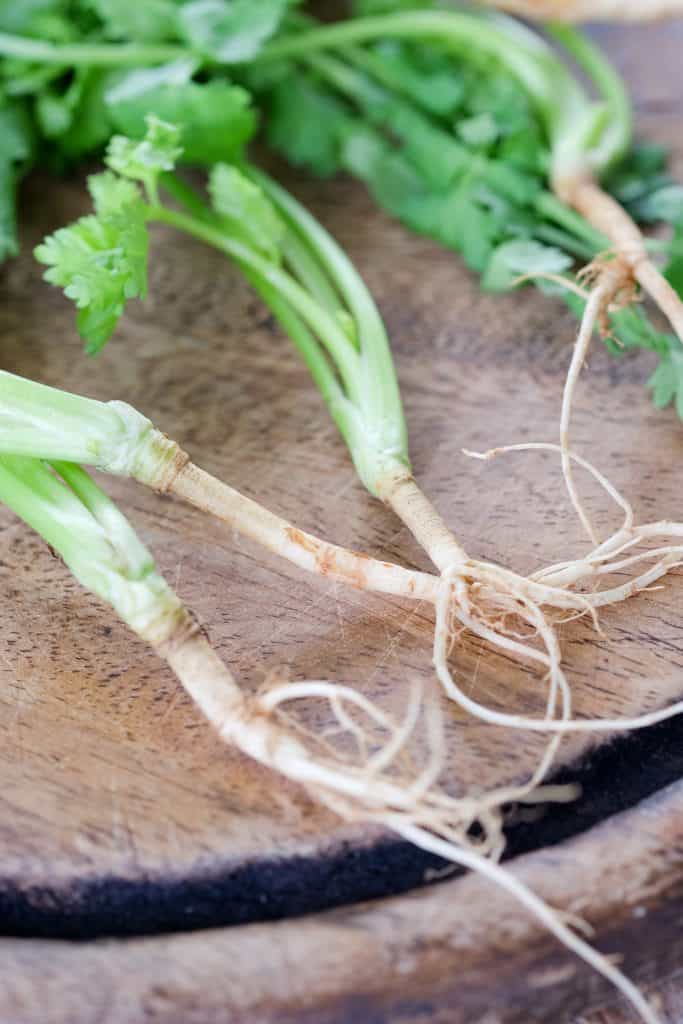
Wildlife, Insects, & Diseases
Deer, rabbits, squirrels, raccoons and more animals will enjoy eating it. Consider fencing and other ways to keep animals out of gardens.
Depending on where you live, insects can infest leaves, stalks, and roots so check plants regularly. Some insects to watch out for include:
- Slugs, snails, cutworms
- Celery leaftiers also called greenhouse leaftiers
- Wireworms
- Earwigs
- Aphids
- Cabbage loopers
- Tomato hornworms
Diseases
You’ll want to check the overall health of the plants by checking for disease. These include:
- Celery mosaic virus
- Early blight, Late blight
- Celery leaf curl
Harvesting Celery
The great thing about growing celery is as you harvest the outer stalks, it will continue to grow. It’s important to pick the ribs from the outside in.
- Get a ruler and measure the stalk from the base to the lowest leaf. If the stalks are a minimum of six to eight inches tall, it’s ready for harvesting.
- Cut it from the base.
What to know about picking celery:
- On average, it takes four and a half months to sow celery.
- Cutting will encourage new growth.
- Pale stems are less nutritious than dark green ones.
- In hardiness zones 2 – 8, you’ll likely harvest it in mid-July into early August.
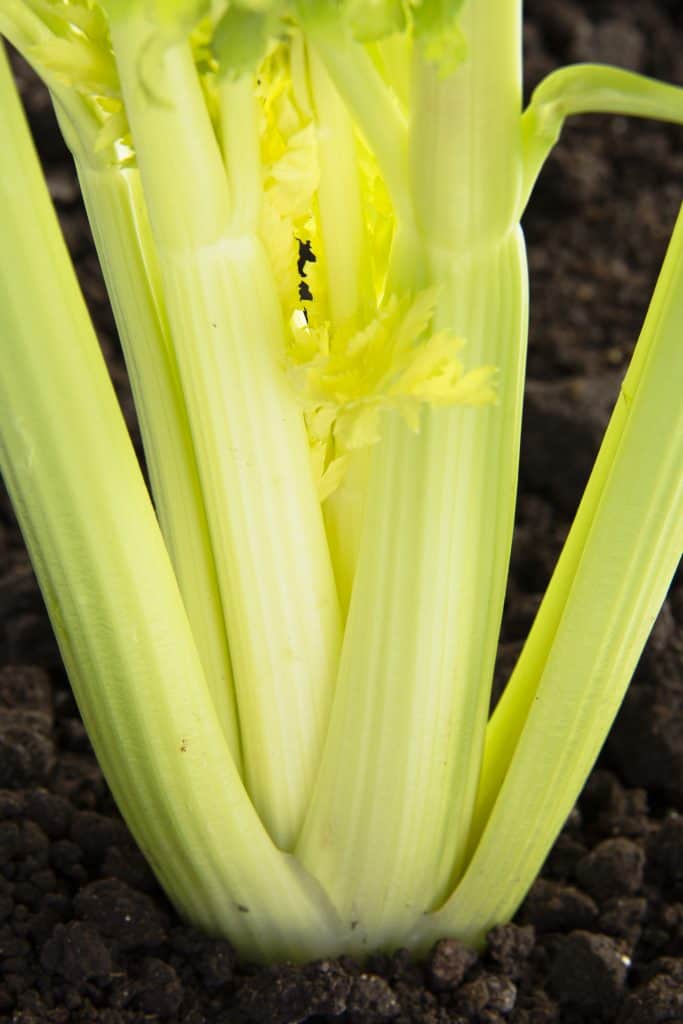
Tips for Growing Celery
Celery prefers cooler temperatures. Most varieties do well with light frost protection because they can be damaged by moderate frost. However, cold weather after transplanting can cause bolting. In hot weather, it will bolt as well. This means it will flower and produce seeds.
After bolting, the stems will be woody and difficult to chew. It will likely be bitter as well.
It’s also important to keep the soil moist. Be sure it is well-draining.
Types of Celery to Plant
If you want to grow celery from celery, chances are there will only be one type available at your grocery store. However, if you can find celery starts or you want to plant celery seeds, there are many celery varieties to choose from.
These are some of the best varieties for home gardens. Choose organic seeds when possible.
- Tango Hybrid
- Grows 15 – 18 inches tall
- 6 inch spread
- Sweet, crunchy
- Tall Utah
- Grows 18 – 24 inches tall
- 12 inch spread
- Dark green stalks
- Pascal Giant
- Two feet tall
- Winter adaptability
- Mild taste when blanched
- Celeriac
- Pale green edible root
- Shoots, leaves, stem all edible
- Also called knob celery, turnip-root
- Golden Self-Blanching
- Blanches on its own
How to Use Celery
Homegrown celery is tasty and can be eaten raw as a snack, cut into salads, including chicken and tuna salad recipes, or cooked in soups, stews, stuffing, as a garnish, and more. You can also juice it.
You can eat celery leaves and the stalks. It’s best when the stalks are tender and crunchy. Freeze what you won’t be able to use.
FAQs about Growing Celery
How long does it take to grow celery?
On average it takes 4.5 months to grow and harvest.
Can I grow celery from a stalk?
Instead of using the stalk to regrow the plant, use the base that’s usually discarded. Cut the bottom root from the stalks, and place in water.
How easy is it to grow celery?
If you have rich soil amended with compost and keep it moist, you can grow it. Much depends on when you plant it and if cold fronts come through. It also doesn’t like the heat. Therefore, because it’s somewhat finicky, it’s considered difficult to grow.
But if you have a celery bottom from the grocery store, try rooting it and transplanting it into a pot. With patience, you can grow it.
What is the best way to grow celery?
It’s really personal preference if you want to grow from seeds, starts, or the bottom. Starts may be difficult to find, depending on where you live. If you have had luck growing seeds indoors and have good lighting, you can start from seed. Be sure to soak seeds overnight to speed up germination.
Does celery grow back after cutting?
Yes, it grows back. Cut stalks from the outside in. Wait until they are a minimum of six inches tall.
Can I grow celery in hydroponics?
Yes, you can grow celery in hydroponics.
Growing Celery in Home Gardens
There’s nothing like homegrown vegetables from the garden. Keeping in mind that it’s mildly frost tolerant and doesn’t do well in heat, you can be successful growing celery. It’s one of the popular winter vegetables to plant. Celery stores well too.
While it’s not recommended for first-time gardeners (especially from seed) and is better for experienced green thumbs, following these tips for how to grow celery will help you grow a successful crop.
Knowing when to plant outdoors is essential. If you live in an area with a cool spring and summer, plant in early spring. If you live in a region with a warm spring and summer, plant toward late summer to enjoy a late autumn or winter harvest. You can also grow it indoors year round.
It’s fun to grow the bottom of celery into another celery plant. You can also do the same to grow lettuce.

